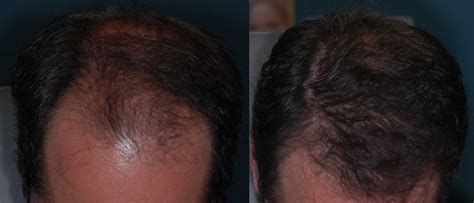1. Follicular Unit Extraction (FUE)
Follicular Unit Extraction (FUE) is a widely-used technique in the field of hair transplantation. It is a minimally invasive procedure that involves extracting individual hair follicles from the donor area and transplanting them into the recipient area. This technique has gained popularity due to its natural-looking results and shorter recovery time compared to other hair transplant methods.
One of the advantages of FUE is that it does not leave a linear scar, unlike the traditional strip harvesting method. Instead, small circular punches are made in the donor area to extract the follicles, which results in tiny, almost invisible scars that heal quickly. This makes FUE a preferred choice for those who prefer to wear short hairstyles or have a donor area that is limited in size.
Another benefit of FUE is that it allows for a more targeted approach in selecting and transplanting individual follicles. This means that the surgeon can carefully choose the healthiest and most suitable grafts for transplantation, resulting in a more natural appearance. The precision of the procedure also ensures minimal damage to the surrounding tissue, leading to faster healing and less post-operative discomfort.
- FUE offers natural-looking and permanent results.
- The procedure is minimally invasive and results in tiny, almost invisible scars.
- It allows for a more targeted selection of grafts, resulting in a more natural appearance.
- Faster healing and less discomfort compared to other hair transplant methods.
| Pros | Cons |
|---|---|
| – Natural-looking results | – Requires experienced surgeon |
| – Minimally invasive | – May require multiple sessions |
| – Faster healing time | – Limited donor area |
In conclusion, Follicular Unit Extraction (FUE) is an advanced technique in hair transplantation that offers natural-looking and permanent results. It is a minimally invasive procedure with faster recovery time and minimal scarring. Despite the need for an experienced surgeon and the possibility of requiring multiple sessions, FUE remains a popular choice due to its precision and ability to achieve a more natural appearance. If you are considering a hair transplant, FUE is definitely a technique worth exploring.
2. Platelet-Rich Plasma (PRP) Therapy
Platelet-Rich Plasma (PRP) therapy is a groundbreaking treatment that is revolutionizing the field of hair restoration. PRP therapy involves using a patient’s own blood to stimulate hair growth and improve the overall health of the scalp. The treatment has gained popularity in recent years due to its effectiveness and minimal side effects.
PRP therapy works by isolating the platelets from the patient’s blood and injecting them into the scalp. Platelets contain growth factors that help to promote hair growth and improve the health of the hair follicles. When injected into the scalp, these growth factors stimulate the production of new hair cells and help to improve the thickness and density of the hair.
One of the key advantages of PRP therapy is that it is a completely natural and non-surgical treatment option. Unlike traditional hair transplant procedures, PRP therapy does not involve any incisions or sutures. Instead, the treatment is performed using a simple injection technique, making it a safe and convenient option for patients.
- Stimulates Hair Growth: PRP therapy stimulates the production of new hair cells and promotes hair regrowth. It can help to rejuvenate dormant hair follicles and improve the thickness and density of the existing hair.
- Improves Scalp Health: PRP therapy improves the overall health of the scalp by increasing blood circulation and delivering essential nutrients to the hair follicles. This helps to nourish the hair follicles and create a favorable environment for hair growth.
- Minimal Side Effects: PRP therapy is a safe and minimally invasive procedure. Since the treatment uses the patient’s own blood, there is no risk of allergic reactions or rejection. The most common side effect is mild swelling or redness at the injection site, which typically resolves within a few days.
Overall, Platelet-Rich Plasma (PRP) therapy offers a promising solution for individuals experiencing hair loss or thinning. Its natural and non-surgical approach makes it an attractive option for those seeking hair restoration treatments. PRP therapy has shown successful results in improving hair growth, enhancing scalp health, and achieving more natural-looking results. If you are considering hair restoration, PRP therapy may be a suitable option to explore.
| Benefits of PRP Therapy for Hair Restoration |
|---|
| Stimulates hair growth |
| Improves scalp health |
| Minimal side effects |
3. Robotic Hair Transplantation Technology
Robotic Hair Transplantation Technology
In recent years, advancements in technology have revolutionized various industries, including the field of hair transplantation. One such breakthrough is robotic hair transplantation technology. This innovative approach combines the precision of robotics with the expertise of hair transplant surgeons to provide remarkable results.
Unlike traditional hair transplantation techniques that rely heavily on manual labor, robotic hair transplantation technology utilizes a robotic arm equipped with advanced imaging systems and artificial intelligence algorithms. This allows for accurate and efficient extraction and transplantation of hair follicles.
One of the key benefits of robotic hair transplantation technology is its ability to ensure consistent and natural-looking results. The robotic arm is programmed to follow the natural hair growth pattern, ensuring that the transplanted hair blends seamlessly with the existing hairline. This level of precision is difficult to achieve using manual techniques alone.
List of advantages of robotic hair transplantation technology:
- 1. Increased precision and accuracy
- 2. Consistent and natural-looking results
- 3. Reduced scarring and faster recovery time
- 4. Minimized human error
- 5. Ability to transplant a larger number of grafts in a single session
In addition to these advantages, robotic hair transplantation technology also offers a more comfortable experience for both the patient and the surgeon. The robotic arm can perform the procedure with minimal human intervention, reducing the risk of fatigue or errors caused by human factors.
Table: A comparison of robotic hair transplantation technology vs. traditional techniques
| Aspects | Robotic Hair Transplantation Technology | Traditional Techniques |
|---|---|---|
| Precision | High | Variable |
| Scarring | Minimal | Potential for more scarring |
| Recovery Time | Shorter | Longer |
| Graft Transplants | High number of grafts in a single session | Limited number per session |
| Human Intervention | Minimal | Significant |
Overall, robotic hair transplantation technology represents a significant advancement in the field of hair restoration. Not only does it offer improved precision and consistent results, but it also allows for a more comfortable and efficient procedure. With further advancements in technology, we can expect even more remarkable developments in the future of hair transplantation.
4. Scalp Micropigmentation (SMP)
Scalp Micropigmentation (SMP), also known as hair tattooing, is a revolutionary hair restoration technique that has gained popularity in recent years. SMP is a non-surgical procedure that involves depositing pigment into the scalp to create the appearance of a full head of hair or to camouflage bald spots and thinning hair. This innovative procedure offers a realistic and natural-looking solution for individuals with hair loss concerns.
One of the key benefits of SMP is its ability to create the illusion of hair density, even in areas where hair growth is minimal. By using pigments that closely match the natural hair color, SMP practitioners can mimic the look of real hair follicles. This technique is especially effective for individuals with thinning hair, receding hairlines, or those who have undergone hair transplantation but want to achieve a fuller and more uniform look.
SMP is a versatile procedure that can be tailored to each individual’s unique needs and desired outcome. Whether you are looking to restore a completely bald scalp, add density to thinning hair, or camouflage scars from previous surgeries, SMP can be customized to address your specific concerns. The pigments used in SMP are carefully selected to match your natural hair color, ensuring a seamless and natural-looking result.
List of advantages of Scalp Micropigmentation:
- Non-surgical: SMP is a non-invasive procedure, which means there are no surgical incisions or long recovery periods. This makes it a safe and convenient option for individuals who are looking for a quick and effective hair restoration solution.
- Durable and long-lasting: Unlike temporary hair loss solutions such as wigs or hair fibers, SMP provides a long-lasting result. The pigments used in SMP are designed to gradually fade over time, offering a natural and realistic-looking effect.
- Low maintenance: Once the SMP procedure is complete, minimal maintenance is required. Unlike traditional hair transplants, which require regular trimming and styling, SMP only requires occasional touch-ups to maintain its appearance.
In conclusion, Scalp Micropigmentation (SMP) is a game-changing hair restoration technique that offers natural-looking results for individuals with hair loss concerns. Whether you are looking to create the illusion of a full head of hair, add density to thinning hair, or camouflage scars, SMP can be tailored to meet your specific needs. With its non-surgical nature, long-lasting results, and low maintenance requirements, SMP is becoming an increasingly popular choice for both men and women seeking a solution to their hair loss woes.
5. Hairline Design and Natural-looking Results
The hairline is an essential aspect of any hair restoration procedure. It plays a crucial role in achieving natural-looking results. A well-designed hairline not only enhances the appearance of the patient but also boosts their confidence. Hairline design requires careful planning and consideration of several factors, including the patient’s facial features, age, and gender.
When designing a hairline, the surgeon aims to create a result that seamlessly blends with the patient’s existing hair, making it appear as natural as possible. This involves determining the appropriate shape, density, and placement of the hairline. Creating a natural-looking hairline involves using single-hair grafts at the front of the hairline and gradually increasing the density towards the back.
Another important aspect of achieving natural-looking results is customizing the hairline for each individual. No two patients have the same hairline, and it is crucial for the surgeon to take into account the patient’s unique features and preferences. By tailoring the design to suit the patient’s specific needs, the surgeon can create a result that seamlessly blends with their existing hair and facial features.
6. Non-surgical Hair Transplant Options
Non-surgical hair transplant options have become increasingly popular in recent years, offering individuals the opportunity to restore their hair without undergoing invasive surgical procedures. These innovative treatments provide effective solutions for individuals experiencing hair loss, giving them the chance to regain their confidence and achieve natural-looking results.
One non-surgical hair transplant option is platelet-rich plasma (PRP) therapy. PRP therapy involves extracting the patient’s own blood, processing it to concentrate the platelets, and then injecting the platelets back into the scalp. This stimulates hair growth by promoting the production of collagen and increasing blood flow to the hair follicles. PRP therapy is a safe and relatively painless procedure that requires no downtime, making it a convenient option for those seeking non-surgical solutions to hair loss.
Scalp micropigmentation (SMP) is another non-surgical hair transplant option that has gained popularity in recent years. This procedure involves depositing tiny pigments into the scalp to create the illusion of hair follicles. SMP can be used to create a natural-looking hairline, conceal scars, or add density to thinning areas. Unlike traditional hair transplants, SMP does not require any surgical incisions and has minimal downtime. It provides a long-lasting solution for individuals looking to enhance their appearance without undergoing surgery.
Laser therapy is yet another non-surgical hair transplant option. This treatment involves using low-level laser light to stimulate hair follicles and promote hair growth. It works by increasing blood flow to the scalp and stimulating cell metabolism. Laser therapy is a non-invasive and pain-free procedure that can be done at home with the use of handheld devices or in specialized clinics. It is suitable for individuals with different stages of hair loss and can be used in combination with other non-surgical treatments for optimal results.
List of Non-surgical Hair Transplant Options:
- Platelet-Rich Plasma (PRP) Therapy
- Scalp Micropigmentation (SMP)
- Laser Therapy
Comparison of Non-surgical Hair Transplant Options:
| Treatment Option | Procedure | Downtime | Results |
|---|---|---|---|
| PRP Therapy | Injection of concentrated platelets into the scalp | Minimal downtime | Visible improvement in hair growth |
| SMP | Deposition of pigments into the scalp | No downtime | Natural-looking hairline and increased hair density |
| Laser Therapy | Low-level laser light stimulation | No downtime | Promotes hair growth and improves scalp health |
These non-surgical hair transplant options offer individuals a range of choices when it comes to addressing hair loss. Whether someone is seeking a non-invasive procedure with minimal downtime or looking to achieve a specific aesthetic result, there are effective non-surgical treatments available. It is important to consult with a qualified hair restoration specialist to determine the most suitable option based on individual needs and goals.
7. Stem Cell Hair Transplantation Research
Stem cell hair transplantation research has emerged as a promising field in the realm of hair restoration. Stem cells, with their ability to self-renew and differentiate into various cell types, hold great potential for regenerating hair follicles and combating hair loss. This innovative approach in hair transplantation is revolutionizing the industry and offering new hope to individuals struggling with hair thinning or baldness.
One of the key advantages of stem cell hair transplantation is its ability to address the underlying cause of hair loss. Traditional hair transplant techniques often focus on the redistribution of existing hair follicles, providing a temporary solution. However, stem cell therapy aims to regenerate and grow new hair follicles, ensuring long-lasting results.
Researchers are exploring various sources of stem cells for hair transplantation, including adipose (fat) tissue, bone marrow, and even embryonic stem cells. These stem cells are extracted, processed, and activated before being carefully injected into the scalp. The activated stem cells stimulate the dormant hair follicles, promoting hair growth and improving hair density.
- Stem cell hair transplantation offers several benefits over traditional methods:
- Natural-looking results: By leveraging the regenerative potential of stem cells, this technique allows for the growth of new hair that blends seamlessly with existing hair, resulting in a natural appearance.
- Increased success rate: Stem cell therapy enhances the survival and growth of transplanted hair follicles, increasing the success rate of the procedure.
- Reduced downtime: Compared to traditional hair transplant techniques, stem cell hair transplantation typically involves minimal downtime, allowing individuals to resume their daily activities sooner.
In addition to assisting with hair restoration, stem cell hair transplantation research also contributes to advancements in the understanding and treatment of other medical conditions. Stem cells have the potential to be used in various regenerative therapies, including tissue regeneration, wound healing, and treatment of degenerative diseases.
| Stem Cell Hair Transplantation Research: | |||
|---|---|---|---|
| Advantages: | Natural-looking results | Increased success rate | Reduced downtime |
| Contributes to: | Tissue regeneration | Wound healing | Degenerative disease treatment |
In conclusion, stem cell hair transplantation research holds immense potential in the field of hair restoration. With its ability to promote the growth of new hair follicles, this innovative technique offers natural-looking results and significantly improves the success rate of hair transplants. Moreover, the ongoing research in this area contributes to advancements in regenerative medicine as a whole. As this field continues to evolve, we can expect even more exciting developments in the quest for effective hair loss treatments.
8. Utilizing Virtual Reality in Hair Restoration Consultations
The advancement of technology has revolutionized many industries and fields, and the field of hair restoration is no exception. One of the latest innovations in this field is the utilization of Virtual Reality (VR) in hair restoration consultations. Virtual Reality is a computer-generated simulation of a three-dimensional environment that can be interacted with in a seemingly real or physical way using special electronic equipment.
With the help of Virtual Reality, potential hair restoration patients can now have a more immersive and realistic experience during their consultations. They can virtually try on different hairstyles and see how they would potentially look after the hair restoration procedure. This technology allows them to visualize and understand the expected results in a more detailed and clearer manner.
Not only does Virtual Reality enhance the visualization aspect, but it also provides a more personalized experience for patients. By utilizing this technology, hair restoration clinics can create customized VR modules that cater to each individual’s specific needs and preferences. This personalized approach ensures that patients feel more involved in the decision-making process and have a clearer understanding of the potential outcomes.
- Improved Visualization: Virtual Reality allows potential hair restoration patients to see themselves with different hairstyles and make more informed decisions.
- Personalized Experience: By utilizing VR technology, clinics can create customized modules that cater to each individual’s specific needs and preferences.
- Clearer Understanding: VR provides a more detailed and realistic representation of the expected results, allowing patients to have a clearer understanding of the outcomes.
| Advantages of Utilizing Virtual Reality in Hair Restoration Consultations |
|---|
| Enhanced Visualization |
| Personalized Experience |
| Clearer Understanding |
Utilizing Virtual Reality in hair restoration consultations not only benefits the patients but also the hair restoration clinics. It helps clinics stand out from their competitors by offering a cutting-edge and innovative approach to consultations. It also reduces the chances of miscommunication or misunderstandings between the patients and the clinicians, as VR provides a more accurate representation of the expected outcomes.
In conclusion, the utilization of Virtual Reality in hair restoration consultations has brought about a significant enhancement in the visualization aspect, personalization, and overall understanding of the potential outcomes. This technology is revolutionizing the way patients and clinicians interact and make decisions regarding hair restoration procedures. As Virtual Reality continues to evolve and improve, it is expected to play an even more significant role in the field of hair restoration.
Frequently Asked Questions
Q: What is Follicular Unit Extraction (FUE)?
A: Follicular Unit Extraction (FUE) is a hair transplant technique that involves individually extracting hair follicles from the donor area of the scalp and then implanting them into the balding or thinning areas. It is a minimally invasive procedure that leaves no linear scars.
Q: How does Platelet-Rich Plasma (PRP) Therapy work?
A: Platelet-Rich Plasma (PRP) Therapy is a non-surgical treatment for hair loss. It involves extracting a small amount of the patient’s own blood, processing it to isolate the platelet-rich plasma, and then injecting it into the scalp. The growth factors present in the platelets stimulate hair follicles and promote hair growth.
Q: What is Robotic Hair Transplantation Technology?
A: Robotic Hair Transplantation Technology is an advanced technique that uses robotic assistance to perform hair transplant procedures. The robotic system can identify and extract individual hair follicles with precision and accuracy, reducing the risk of damage to the grafts and ensuring natural-looking results.
Q: What is Scalp Micropigmentation (SMP)?
A: Scalp Micropigmentation (SMP) is a non-surgical technique that involves tattooing tiny dots or lines on the scalp to mimic the appearance of hair follicles. It is commonly used to create the illusion of a shaved or fuller head of hair, and it can also be used to camouflage scars or add density to thinning areas.
Q: How important is hairline design for natural-looking results?
A: Hairline design is crucial for achieving natural-looking results in hair transplant procedures. An experienced surgeon will carefully consider factors such as the patient’s age, facial features, and existing hair pattern to create a hairline that blends seamlessly with the individual’s appearance. A well-designed hairline can significantly enhance the overall outcome of a hair transplant.
Q: What are the non-surgical options for hair transplant?
A: Non-surgical options for hair transplant include PRP therapy, scalp micropigmentation (SMP), and the use of hair loss medications such as minoxidil or finasteride. These options offer alternatives for individuals who are not suitable candidates for surgical procedures or who prefer non-invasive treatments.
Q: What is the current status of Stem Cell Hair Transplantation Research?
A: Stem Cell Hair Transplantation is an area of ongoing research and development. Scientists are exploring the potential of using stem cells to regenerate hair follicles and create new hair growth. While promising results have been achieved in preclinical studies, further research is needed before stem cell hair transplantation becomes a widely available treatment option.
Q: How can Virtual Reality be utilized in hair restoration consultations?
A: Virtual Reality (VR) technology can be used in hair restoration consultations to give patients a visual simulation of how they might look with different hair transplant outcomes. VR allows patients to virtually try different hairline designs, densities, and styles before undergoing the actual procedure, giving them a better understanding of the potential results and helping them make informed decisions about their treatment.





